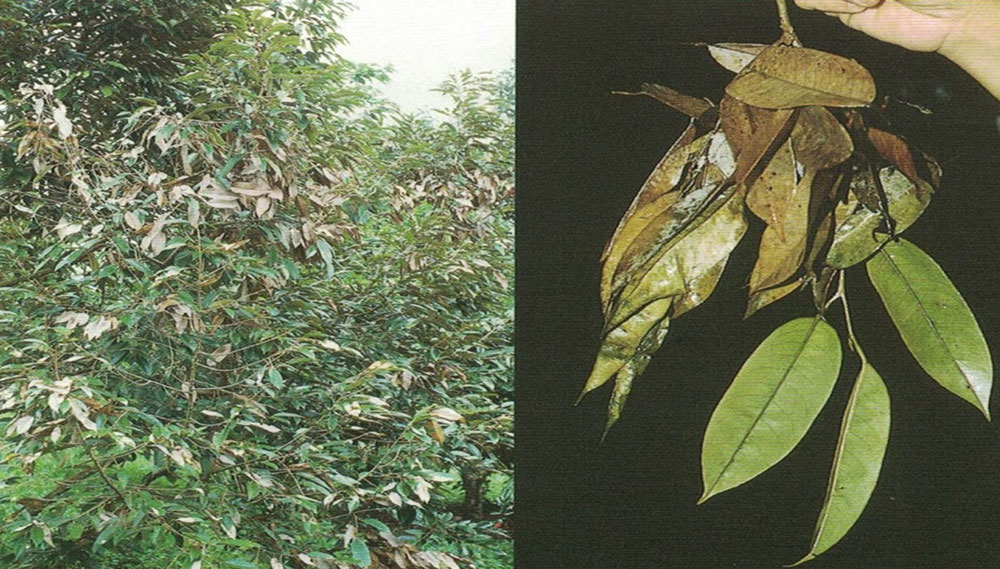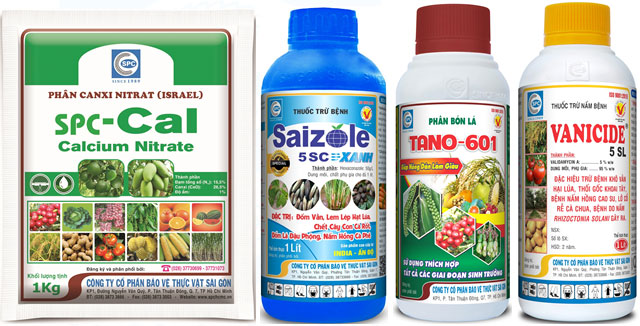|
Prevention Of Leaf Blight Disease
31/07/2021
Ph.D. Nguyen Minh Tuyen Durian is one of the fruit trees with high economic benefits. However, in the rainy season, durian trees often encounter some specific diseases. Leaf blight is one of the dangerous diseases in the rainy season for durian. Symptoms and effects: The disease affects both young and old leaves, both in nurseries and large orchards. On the leaves, the lesions have no discernible shape. It is a small bluish spot at first, then gradually spreads to brown, and finally to gray. When the environment is humid and high temperature, the disease easily spreads to other leaves standing close, causing the leaves to stick together and possibly black rot. The disease can also attack young branches and dry them out. Severe disease will make the entire leaves white dry, making the plant lose the ability to photosynthesize and be weakened, lose strength.
Pathogens and suitable conditions for the disease to arise and develop: The disease is caused by the Rhizoctonia solani fungus. - The disease develops during the rainy season, when the environment is temperate, with high humidity. In particular, the disease often arises and thrives in the conditions of thick gardens, little care, or unreasonable care such as unbalanced fertilization, excess nitrogen and lack of trace elements. The garden is not pruned with diseased branches, ineffective branches, with dense foliage, shaded, the garden lacks sunlight and is not well ventilated… often severely damaged. Preventive measures: - Regularly clean the garden, clean up the remnants of disease, clean up the weeds around the garden and destroy... Do not let water from other places overflow into the garden. - Do not plant too thickly, prune ineffective branches at the beginning of the rainy season so that the tree has enough light and ventilation to enhance disease resistance. - Apply fertilizer in a reasonable balance, without excess nitrogen, adding medium and micro fertilizers such as TANO-601. Increase the application of decayed organic fertilizers and SPC- CAL. - When the weather is suitable for the disease to arise and develop (as mentioned above), proactively prevent it, such as limiting the use of nitrogen fertilizers, increasing potassium fertilizers and spraying preventive products. - Monitor the garden regularly, especially during the period when the weather is suitable for disease development. When early disease appears in the garden, stop using nitrogen fertilizers and immediately spray one of the following products. + SAIZOLE 5SC, or VANICIDE 5SL. + If the disease develops strongly, it can be sprayed again after 5-7 days. Attention when spraying: Spray enough water with a fine nozzle to loosen the mist, need to spray to the top of the tree. Spray when the tree has dried dew, drained after rain or sprayed in the cool late afternoon. |
To prevent, in addition to plowing and burying weed seeds, collecting weed stalks and stumps left after tilling the land to burn, not letting weeds produce seeds in production fields, etc., the use of chemical products is still a measure. optimal because of its ability to thoroughly kill weeds, reduce labor and take advantage of more time than manual weeding.
Miner has the scientific name Phyllocnistis citrella Staint., family Phyllocnistidae, order Lepidoptera. The miner occurs in many countries in the tropics and subtropics. The main host of the miner is the citrus family - Rutaceae. In addition, the miner also attacks mangosteen and some other plants.
Adult is a small planthopper, with a body 2-3 mm long, the whole body is ash gray, slightly greenish, the wings are opaque with many small brown spots.Eggs are oval, 0.3 mm long, have a pointed end and are attached directly to the leaf surface, leaf axils.
Green bugs specialize in the fruit of citrus groups (oranges, tangerines, lemons, grapefruits, kumquats...), some people call them orange bugs, or orange suckers. Their scientific name is Rhynchocoris poseidon or Rhynchocoris humeralis.
In Vietnam, yellow leaf curl disease is very common on papaya trees, especially the disease is often severe in areas of high and continuous planting, areas with hot and arid climates. The disease has significantly reduced the yield and quality of papaya. Gardens that are infected early when the plants are young may not yield. However, up to now, many gardeners still do not know the cause and how to fix it.
Spider mites are common pests on citrus trees, especially in hot and dry climates that are suitable for spiders to grow and cause severe damage.The group of harmful spiders is usually very small in size, unlike the natural enemy spiders.
This group includes species that are generally very small in size, causing damage by sucking plant sap (on leaves, fruits, branches, stems).
There are many species of mealybugs present on the group of Oranges,Tangerines,Grapefruits and Lemons (Citrus), which can be divided into 2 groups:
+ Group of sticky mealybugs with common varieties such as Lepidosaphes, Aonidiella, Coccus and Saissetia.
+ Group of flower mealybugs with common genera and species such as Pseudococcus, Planococcus and Icerya purchasi.
Dry branches and berries disease often appear to be common damage on coffee gardens during the rainy season. The disease causes death of branchs, dry fruit, severely affects the canopy structure and coffee yield if not paid attention to prevention.
Pink disease commonly causes diseases on rubber plantations in the rainy season, especially on garden from 4-8 years old. This year, rubber has to go through a period of severe drought, weakening the tree, so now in tnshe rainy season it is easy to get infected. Therefore, it is necessary to pay attention to good management to avoid affecting the garden.
In recent years, the area of citrus has been expanded because it is a fruit tree with high economic efficiency. However, in order to sell at a high price, not only in quality but consumers also require the external beauty of the fruit, so pest management on citrus is a matter of great concern to farmers. The hot season is a favorable condition for thrips to develop and cause damage, affecting the commercial value of fruit.
- Headquarters
- SAIGON PLANT PROTECTION JOINT STOCK COMPANY
- RQ 1, Nguyen Van Quy St., Tan Thuan Ward, HCM City
- Tax code: 0300632232
- Tel: (028) 38 733 295 - 38 732 077
- Fax: (028) 38 733 003 - 38 733 391
- Website: www.spchcmc.vn - Email: info@spchcmc.vn
- SAIGON PLANT PROTECTION COMPANY
- SAIGON PLANT PROTECTION JOINT STOCK ENTERPRISE
- Lot C1-C3 Hiep Phuoc Industrial Park, Hiep Phuoc Commune, HCM City
- Tel: (028) 3873 4089 - Fax: (028) 3873 4086
- Affiliated Unit
-
- Quick Links
- Home
- About us
- Career Opportunities













